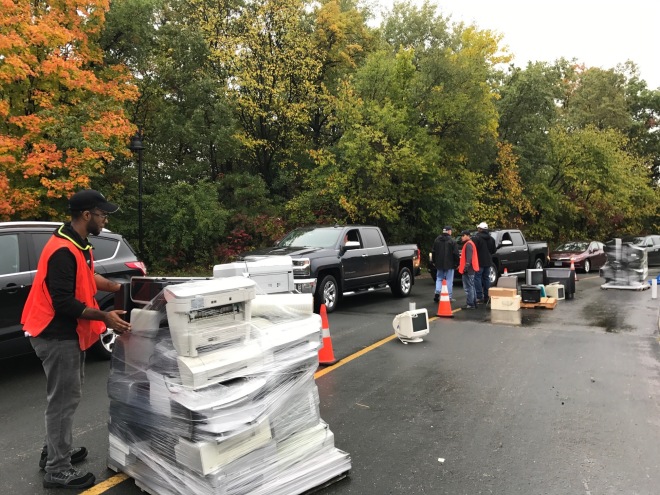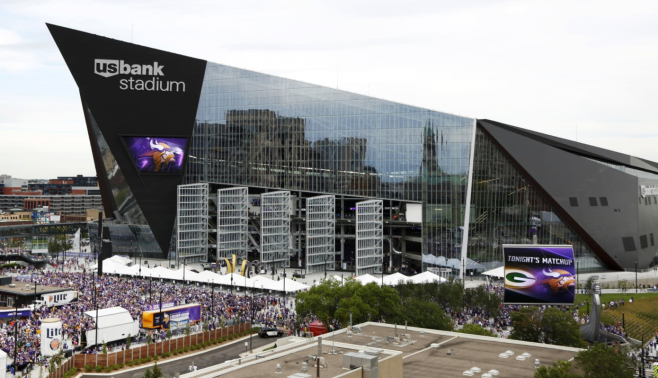Super Bowl LIII Week is in full swing in Atlanta, complete with red carpet galas, fan-fests, and Media Day, all leading up to Sunday night’s battle between the New England Patriots and Los Angeles Rams.
From a sustainability perspective, Atlanta has a leg up on other host cities since the game will be played inside Mercedes-Benz Stadium, the first LEED Platinum professional sports stadium in North America.
GreenSportsBlog spoke with Tim Trefzer, the Atlanta Super Bowl LIII Host Committee’s Sustainability Chair, to see what is going on green-wise beyond the stadium.
GreenSportsBlog: Atlanta has been the center of the Mega-Sports event and Green-Sports worlds over the past 18 months. Mercedes-Benz Stadium hosted the 2018 College Football National Championship last January and the Green Sports Alliance Summit in June. It also was the site of the Major League Soccer All-Star Game in July and MLS Cup in December. And of course this Sunday, Super Bowl LIII comes to town. And Tim Trefzer, you are at the heart of the Green-Sports action as Sustainability Chair of the Atlanta Super Bowl Host Committee. Thanks for talking with us at what must be a crazy busy time.
Tim Trefzer: My pleasure. And yes, it’s been busy, really going back to the 2018 College Football Playoff National Championship, as I handled a similar sustainability role for that event as well. And we, along with Georgia Tech, will play host to the 2020 NCAA Men’s Final Four so we’ve got more mega-events coming down the pike!

Tim Trefzer, sustainability chair of the Atlanta Super Bowl 53 Host Committee (Photo credit: Tim Trefzer)
GSB: That is not a surprise, what with Mercedes-Benz being the state of the art in stadium design across all metrics, including sustainability through its LEED Platinum status. So with that as backdrop, how has the Atlanta Super Bowl LIII Host Committee approached the event through a green lens?
Tim: We are working closely with Jack Groh of the NFL — he’s managed the league’s Super Bowl greening efforts for over two decades — to make the most of the league’s four sustainability pillars. Number one is Material and Resource Recovery. We are working with local Atlanta organizations on food, textile, and other material donations that will come from the game, the many ancillary events, and participating hotels. Our partners include the Atlanta Community Food Bank, Salvation Army, and Habitat for Humanity. We also assisted Verizon, an NFL environmental sponsor, with their annual E-waste recycling event in the run up to the Super Bowl. Ours was at Zoo Atlanta and it was a big success as 42,446 lbs. of electronics were collected, the most ever from this event!

Some of the electronic waste collected as part of Verizon’s e-waste recycling event at Zoo Atlanta on January 19 (Photo credit: Fox 5 Atlanta)
GSB: Congratulations! What about pillar number two?
Tim: Urban Forestry. This is more than a tree planting effort. In collaboration with the City of Atlanta’s Office of Resilience and Trees Atlanta, we are supporting 13 projects, including community gardens, a 7.1-acre food forest with fruit trees and vegetable plantings, and even pollinator projects. Pillar number three is Super Kids, Super Sharing…
GSB: That’s been around for some time…
Tim: This is its 20th anniversary — it started in Atlanta, by the way. The program’s essence is a used sports equipment and school supply exchange that keeps footballs, soccer balls and more out of landfills and gives them a second life. Kids from donor schools bring their equipment to a facility where it is sorted; then receiving schools come in. It gets kids thinking about the circular economy at a young age and exposes them to other kids in the Atlanta area from different walks of life. Over 100 schools committed to take part. Last year, the folks at the Minneapolis’ Super Bowl LII Host Committee collected 46,000 items — we’re hoping to beat that when all is said and done.
Two minute video showing highlights from Atlanta’s Super Kids Super Sharing event
GSB: Good luck. Finally, what’s the fourth pillar?
Tim: Pillar number four is renewable energy. The NFL buys renewable energy credits to offset all of the electricity used at the stadium and everything surrounding it. That includes the host hotels, the Georgia World Congress Center…
GSB: …The convention center campus adjacent to Mercedes-Benz Stadium where you are the sustainability director.
Tim: Exactly… Also, it’s not by accident that Centennial Olympic Park, the Georgia World Congress Center, and many hotels are a short walk from Mercedes-Benz Stadium, In fact, of the 15 major NFL events taking place during Super Bowl, 13 are taking place in or adjacent to the Georgia World Congress Center Authority’s downtown Atlanta campus (which includes the stadium, convention center, and Centennial Olympic Park). Of recent Super Bowls, the most taking place in the same vicinity has been seven.
GSB: Those are four strong pillars that the NFL and the Host Committee are building. Going beyond the NFL’s green work, at the Bay Area’s Super Bowl 50 in 2016, the local Host Committee made the environment the prime focus of their work, which is why I call it the Greenest Super Bowl Ever. That was not the case with Super Bowls LI (Houston, which did nothing as far as I could tell on the environment) and LII (Minnesota, which had a 91 percent waste diversion rate at the game among other local efforts, but they were focused mainly on health care, in part due to the sterling reputation of the Mayo Clinic). What is the Host Committee doing, from an environmental perspective, beyond the four pillars?
Tim: Great question, Lew. One main theme of the Atlanta Super Bowl LIII Host Committee’s work is civil rights and social justice, given the movement’s tremendous history in the city, from Martin Luther King Jr. to HBCUs^ like Morehouse College and much, much more. From public forums to public arts projects, Atlanta’s civil rights heritage has been on display in the run-up to Super Bowl LIII. That said, the Committee and our Sustainability Advisory Council — made up of leaders from Hartsfield-Jackson Atlanta International Airport, top local corporations like Delta Airlines, nonprofits like Trees Atlanta, Scott Jenkins, GM of Mercedes-Benz Stadium and Board Chairman of Green Sports Alliance, and more — have been working for the better part of the past year on a variety of initiatives, including pushing the sustainability story surrounding Super Bowl LIII and Atlanta.
GSB: Communicating sustainability to fans? Music to my ears!
Tim: A video about recycling at the Airport is being shown around the city. On game day, there will be a full-page, sustainability-themed ad in the game program and we will have ambassadors on the concourses at Mercedes-Benz talking to fans about our sustainability efforts and encouraging recycling. But another reason that these large events keep choosing to come to Atlanta, in addition to the great venues and close proximity, is the fact that they’re LEED certified. In addition to Mercedes-Benz Stadium, Georgia World Congress Center is the largest LEED Gold certified convention center in the world and many of the other event venues are also certified. Arguably, Atlanta is one of the greenest places for conventions, sports, and events anywhere.
GSB: Will there be sustainability-themed scoreboard messaging and/or video shown in-stadium before or during the game? And will CBS Sports and/or CBS Sports Network air that kind of video during the almost endless pregame coverage? That last question is really for the NFL but I thought you might have some inside information.
Tim: Discussions about video board messaging were still ongoing as of a couple of weeks ago. No firm word yet has come across my transom. And you’re right about airing environmental PSAs — that’s the purview of the NFL and CBS. For our part, we will be tracking recycling and waste diversion rates; the Host Committee communications team is working with the NFL and the Georgia World Congress Center Authority to spread the word to the massive amount of media who will be here.

Sustainability-focused messaging on the Mercedes-Benz Stadium video board during an Atlanta United MLS match in June. Will similar messaging greet Super Bowl LIII fans on Sunday? Stay tuned (Photo credit: Lewis Blaustein)
GSB: Will the Host Committee track media pick up of Super Bowl LIII sustainability stories or is that the purview of the NFL?
Tim: I’m sure this is something we could do on social media and include in a report following the event.
GSB: We will take you up on that, Tim. In the meantime, enjoy the game.
^ HBCUs = Historically Black Colleges and Universities





